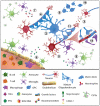Current status of neuroprotective and neuroregenerative strategies in multiple sclerosis: A systematic review
- PMID: 33870797
- PMCID: PMC8688986
- DOI: 10.1177/13524585211008760
Current status of neuroprotective and neuroregenerative strategies in multiple sclerosis: A systematic review
Abstract
Background: Immune-mediated demyelination and consequent degeneration of oligodendrocytes and axons are hallmark features of multiple sclerosis (MS). Remyelination declines in progressive MS, causing permanent axonal loss and irreversible disabilities. Strategies aimed at enhancing remyelination are critical to attenuate disease progression.
Objective: We systematically reviewed recent advances in neuroprotective and regenerative therapies for MS, covering preclinical and clinical studies.
Methods: We searched three biomedical databases using defined keywords. Two authors independently reviewed articles for inclusion based on pre-specified criteria. The data were extracted from each study and assessed for risk of bias.
Results: Our search identified 7351 studies from 2014 to 2020, of which 221 met the defined criteria. These studies reported 262 interventions, wherein 92% were evaluated in animal models. These interventions comprised protein, RNA, lipid and cellular biologics, small molecules, inorganic compounds, and dietary and physiological interventions. Small molecules were the most highly represented strategy, followed by antibody therapies and stem cell transplantation.
Conclusion: While significant strides have been made to develop regenerative treatments for MS, the current evidence illustrates a skewed representation of the types of strategies that advance to clinical trials. Further examination is thus required to address current barriers to implementing experimental treatments in clinical settings.
Keywords: Multiple sclerosis; demyelination; neuroprotection; neuroregeneration; oligodendrocytes; remyelination; therapeutics.
Conflict of interest statement
Figures




Similar articles
-
Recent Advances on Immunosuppressive Drugs and Remyelination Enhancers for the Treatment of Multiple Sclerosis.Curr Pharm Des. 2021 Oct 5;27(30):3273-3280. doi: 10.2174/1381612827666210127121829. Curr Pharm Des. 2021. PMID: 33504299
-
The role of oligodendrocytes and oligodendrocyte progenitors in CNS remyelination.Adv Exp Med Biol. 1999;468:183-97. doi: 10.1007/978-1-4615-4685-6_15. Adv Exp Med Biol. 1999. PMID: 10635029 Review.
-
Remyelination in multiple sclerosis: realizing a long-standing challenge.Expert Rev Neurother. 2015;15(12):1369-72. doi: 10.1586/14737175.2015.1112740. Epub 2015 Nov 11. Expert Rev Neurother. 2015. PMID: 26558886
-
Remyelination in multiple sclerosis: cellular mechanisms and novel therapeutic approaches.J Neurosci Res. 2015 May;93(5):687-96. doi: 10.1002/jnr.23493. Epub 2014 Oct 7. J Neurosci Res. 2015. PMID: 25287108 Review.
-
Remyelination: what are the prospects for regenerative therapies in multiple sclerosis?Emerg Top Life Sci. 2021 Nov 12;5(5):705-709. doi: 10.1042/ETLS20210164. Emerg Top Life Sci. 2021. PMID: 34415022
Cited by
-
Translation of cell therapies to treat autoimmune disorders.Adv Drug Deliv Rev. 2024 Feb;205:115161. doi: 10.1016/j.addr.2023.115161. Epub 2023 Dec 22. Adv Drug Deliv Rev. 2024. PMID: 38142739 Free PMC article. Review.
-
Neuroprotective strategies in multiple sclerosis: a status update and emerging paradigms.Expert Rev Neurother. 2025 Jul;25(7):791-817. doi: 10.1080/14737175.2025.2510405. Epub 2025 Jun 3. Expert Rev Neurother. 2025. PMID: 40440559 Free PMC article. Review.
-
ALCAM on human oligodendrocytes mediates CD4 T cell adhesion.Brain. 2024 Jan 4;147(1):147-162. doi: 10.1093/brain/awad286. Brain. 2024. PMID: 37640028 Free PMC article.
-
Central nervous system demyelinating diseases: glial cells at the hub of pathology.Front Immunol. 2023 May 16;14:1135540. doi: 10.3389/fimmu.2023.1135540. eCollection 2023. Front Immunol. 2023. PMID: 37261349 Free PMC article. Review.
-
Pharmacological targeting of smoothened receptor cysteine-rich domain by Budesonide promotes in vitro myelination.Front Mol Neurosci. 2024 Oct 15;17:1473960. doi: 10.3389/fnmol.2024.1473960. eCollection 2024. Front Mol Neurosci. 2024. PMID: 39473481 Free PMC article.
References
-
- Dua TRP. Atlas: Multiple sclerosis resources in the world. Geneva: World Health Organization, 2008.
-
- Trapp BD, Nave KA. Multiple sclerosis: An immune or neurodegenerative disorder? Annu Rev Neurosci 2008; 31: 247–269. - PubMed
-
- Baird JF, Cederberg KLJ, Sikes EM, et al.. Physical activity and walking performance across the lifespan among adults with multiple sclerosis. Mult Scler Relat Disord 2019; 35: 36–41. - PubMed
-
- Lubetzki C, Zalc B, Williams A, et al.. Remyelination in multiple sclerosis: From basic science to clinical translation. Lancet Neurol 2020; 19(8): 678–688. - PubMed
Publication types
MeSH terms
Grants and funding
LinkOut - more resources
Full Text Sources
Other Literature Sources
Medical
Miscellaneous

